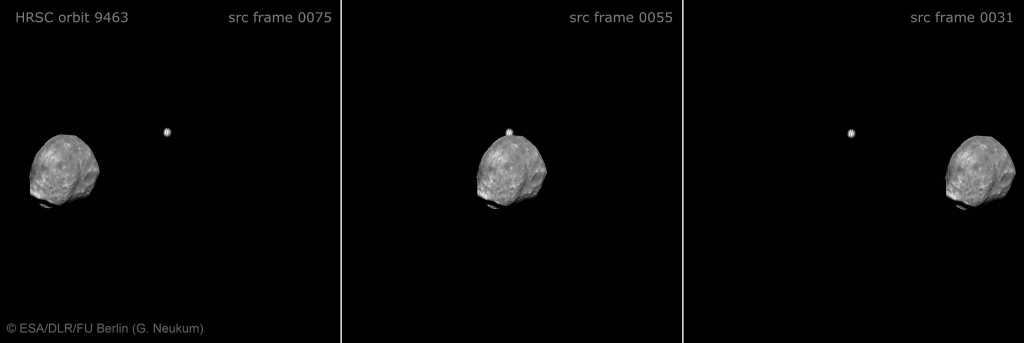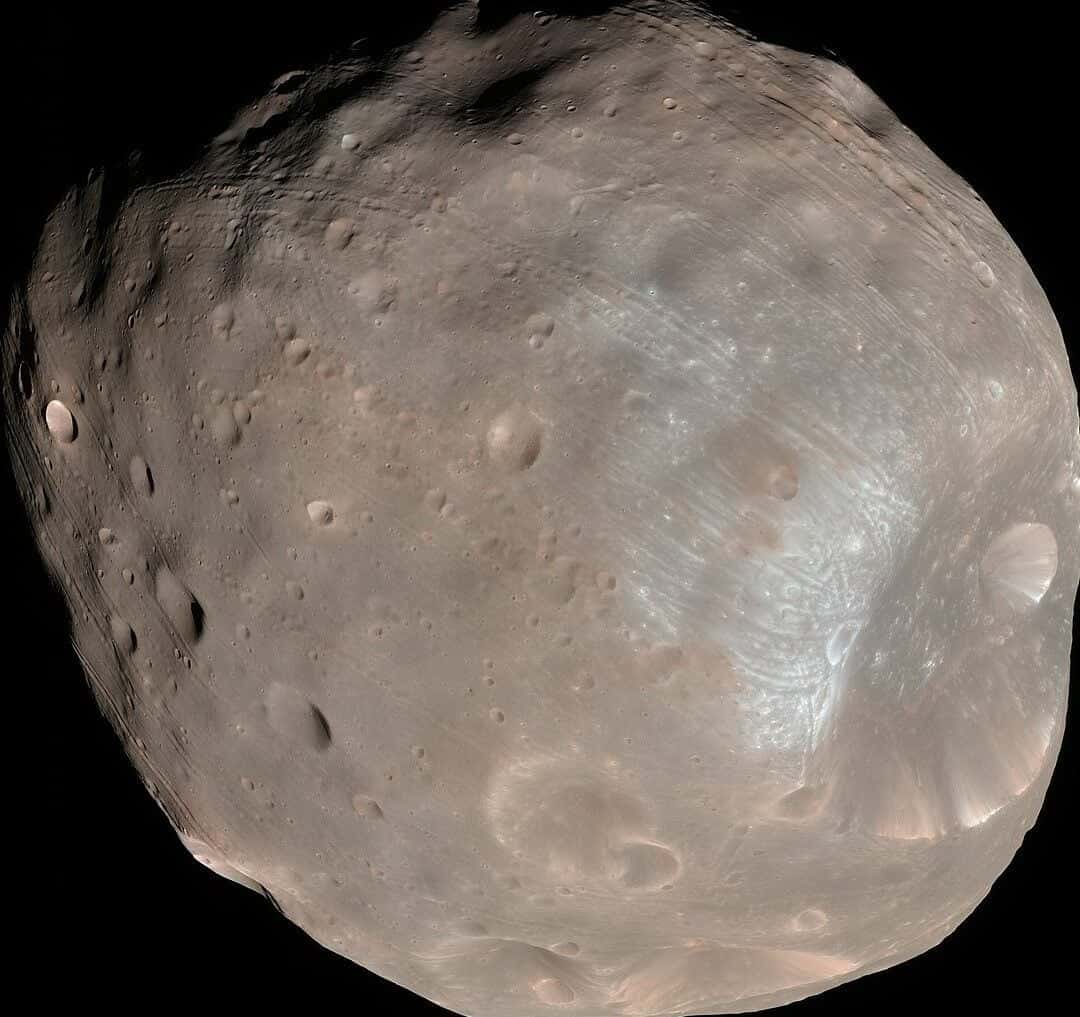
Cosmos
Phobos, the nearest of Mars’ two satellites, was found in 1877 by American astronomer Asaph Hall. It is larger than its companion, Deimos. In Greek mythology, Phobos is a god associated with fear. He is one of the sons of Aphrodite, the goddess of love and beauty, and Ares, the god of war.
What is Phobos?
Phobos is a small moon that orbits Mars and has dimensions of 27x22x18 km. It is the closest natural satellite to its planet in the entire solar system, at a distance of only 9377 km. In comparison, Earth’s Moon is 384,399 km away from our planet, making Phobos almost 41 times closer to Mars than the Moon is to Earth. The surface of Phobos is covered in craters, dents, and depressions, giving it an irregular ellipsoidal shape with three axes.
And here’s an interesting fact: The term “phobia” is directly linked to the ancient Greek god Phobos.
Physical attributes of the Mars moon
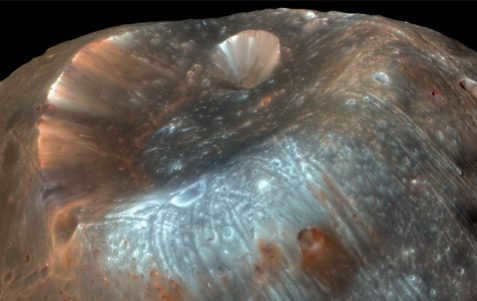
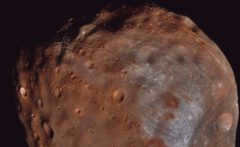
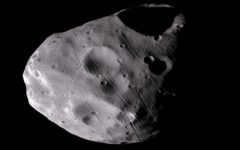
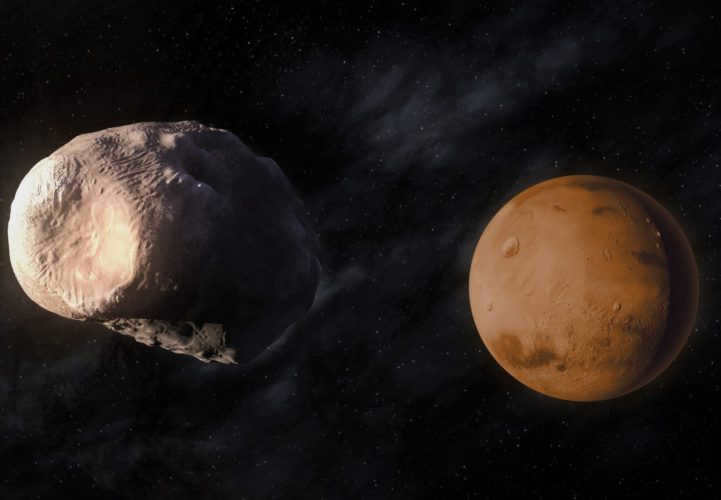
The dimensions of Phobos are approximately 26.8 x 22.4 x 18.4 km. It has a diameter of 22.5 km and covers an area of over 1600 km2. Due to its relatively small mass of 1.072×1016 kg, which is comparable to the size of a city, Phobos lacks an atmosphere. The surface temperature is around 233 degrees Kelvin, equivalent to -40℃ in Celsius.
Phobos can be classified as a dwarf satellite, although it is nearly twice the size of Deimos. Its close proximity to Mars allows it to be visible from the Martian surface as a small, bright dot in the sky.
Phobos resembles an asteroid in its shape and structure. Some astronomers propose that it is simply a large block of stone that was gravitationally attracted to Mars.
Fascinating tidbit: despite the absence of significant gravity on Phobos, the soil manages to remain attached to the celestial body.
The chemical makeup of Phobos
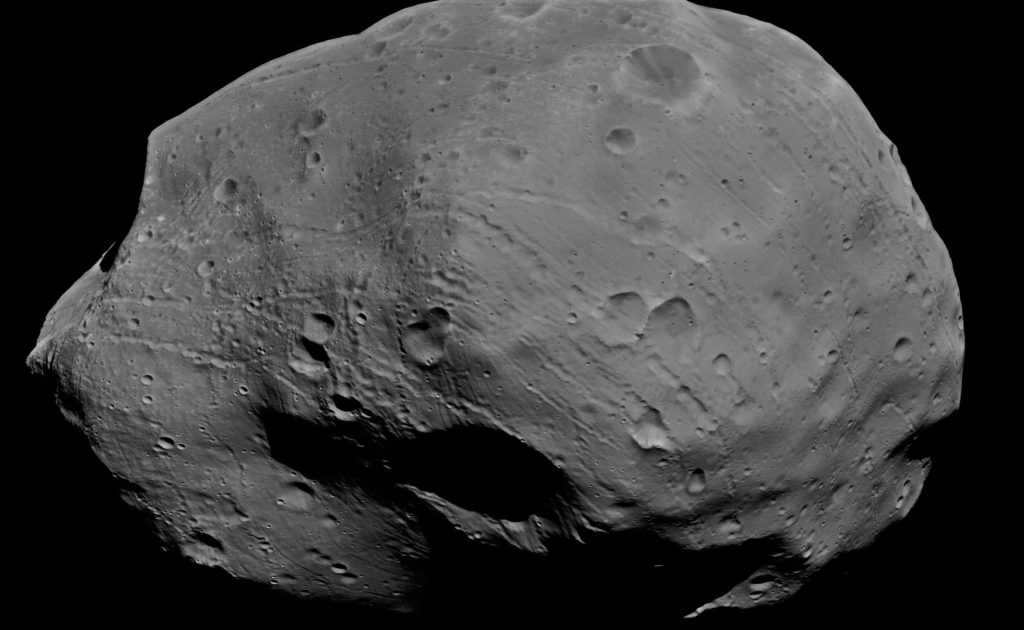
The surface of Mars’ moon is made up of carbon-rich rocks, creating a landscape covered in a fine, loose soil resembling sand. This soil is a combination of rocks and ice, and is believed to have formed as a result of collisions with other celestial bodies and erosion.
The presence of depressions and craters on Phobos suggests that it has experienced impacts from meteorites. These furrows, which can reach depths of over 30 meters and stretch for 20 kilometers, vary in width from 100 to 200 meters. Previously, scientists attributed these features to the shattering of material during collisions. However, modeling has revealed that the moon’s surface is actually “cracking at the seams” due to the gravitational pull of Mars’ tides.
Did you know: The craters on Phobos are organized in a systematic pattern, creating straight lines. The reason behind this phenomenon still remains a mystery to scientists.
Due to the unsuccessful mission, the precise chemical makeup of this celestial object remains unknown. However, further samples are scheduled to be collected in 2030.
Characteristics of the orbit
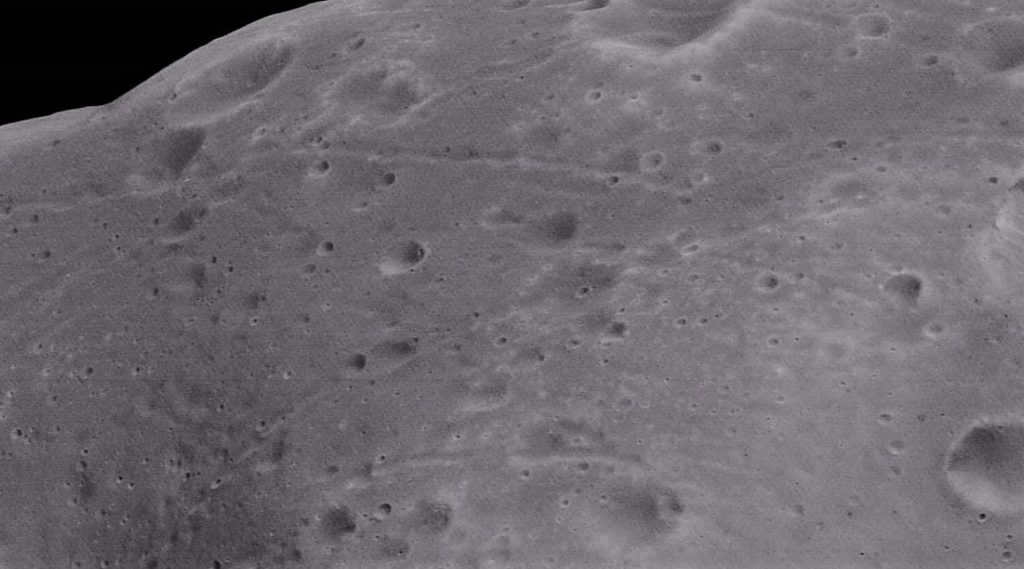
Mars and Phobos are located approximately 9.4 thousand kilometers apart. The satellite’s orbit is constantly changing and every 100 years it gets about 2 meters closer to Mars. This is because of the gravitational force between Phobos and the Red Planet, as well as Phobos’ own rotation which is almost 3 times faster than Mars’ rotation. In other words, the satellite revolves around Mars at a faster pace than the planet itself rotates on its axis. Phobos has an average radius of only 11.1 km.
The initial velocity of Phobos in space is 7 m/s. This speed allows it to maintain its position and not fall or drift off into open space. The satellite does not have its own magnetic field.
Angular dimensions: rephrased
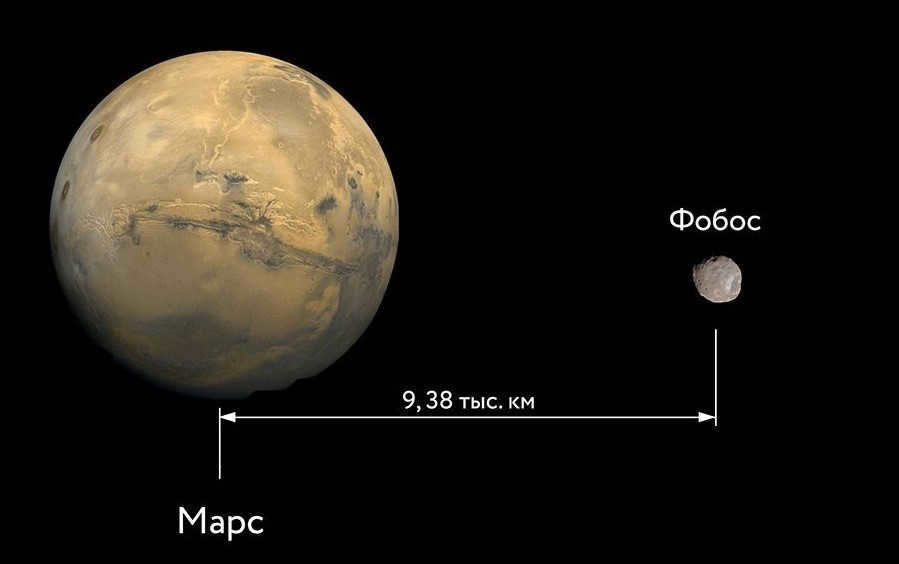
When compared to the Moon, the satellite Phobos appears as a minuscule speck. However, in terms of distance from their respective planets, Phobos is much closer to Mars, making it highly visible in the Martian sky.
When viewed at the horizon, Phobos has an angular diameter of 0.14 degrees, which increases to almost 0.20 degrees at the zenith. This is equivalent to one-third of the full Moon’s angular diameter. Additionally, the Sun in the Martian sky has an apparent size of approximately 0.35 degrees.
If one were to observe Mars from the surface of Phobos, the planet would appear nearly 6,500 times larger and 2,500 times brighter than the full Moon as seen from Earth.
Source
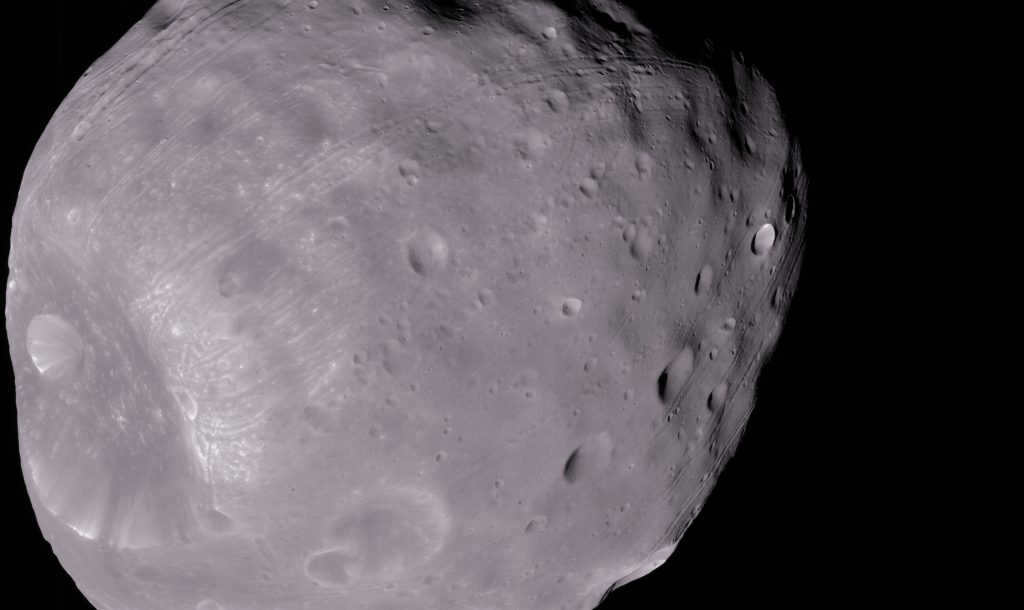

There is no single accepted explanation for the origin of Mars’ satellite. In the 20th century, it was believed to be an artificial object due to its almost hollow structure.
In the 21st century, research has revealed that Phobos exhibits certain compositional characteristics that suggest it belongs to asteroid types C and D. Early speculations suggested that it may have been mistaken for a celestial body from the Main Asteroid Belt, which formed approximately 4.5 billion years ago. Over time, it, along with the second satellite Deimos, gradually moved closer to the Sun until it became a satellite of Mars.
Thanks to the Mars Express, a European space station that explores the planet Mars, scientists have obtained precise data that has led to the development of a brand-new hypothesis. Based on these findings, it is now believed that Phobos, one of Mars’ moons, is not a solid object. Instead, it is thought to have originated from a collision that occurred long ago between Mars and a celestial body called a planetesimal. This collision caused rocks from Mars to be ejected into space, eventually coming together to form Phobos. This suggests that Phobos did not form at the same time as Mars, but rather assembled itself in orbit from the fragments of the collision. Similar events were common during the early stages of our solar system’s formation.
The unveiling
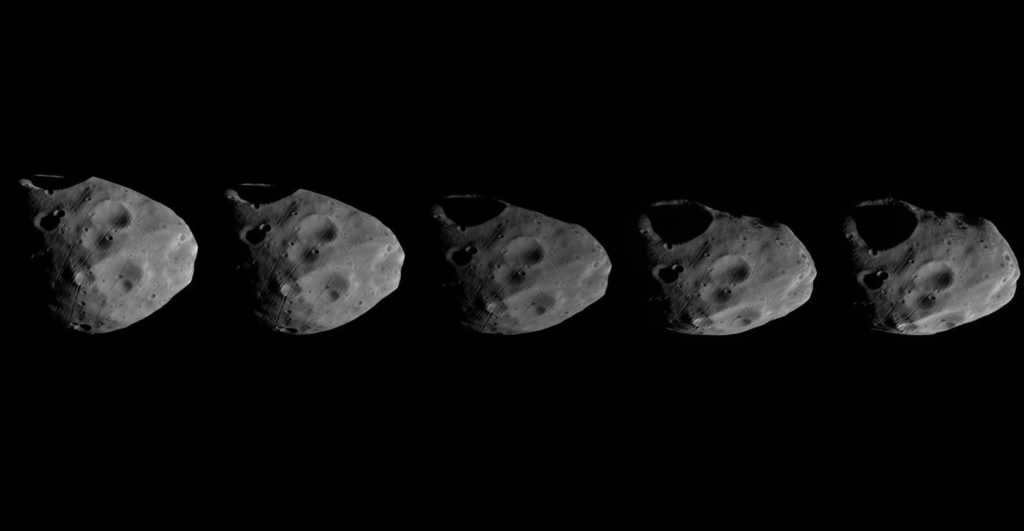

During the time when Mars was in great opposition, Asaph Hall, an astronomer from the United States and a member of the U.S. National Academy of Sciences, made a remarkable discovery. This discovery took place at the Washington Observatory on August 18, 1877.
Fun fact: It was actually a schoolgirl from England who suggested to Hall that he name the celestial bodies after the sons of the ancient Greek god of war Ares (Mars), who were always by his side. One was named Fear and the other was named Terror. In ancient mythology, they are known as Phobos and Deimos.
Exploration
Back in 1969, the Mariner 7 space station successfully captured close-up images of the shadow of Phobos on Mars. Upon further examination, it was revealed that the satellite has an elliptical shape in cross-section, which is twice as large as what astronomer Gerard Kuiper had previously calculated. Moreover, the surface of Phobos was found to have a reflectivity of 5-6%.
Subsequently, many other space stations also managed to photograph Phobos while exploring Mars. Mariner-9 accomplished this feat in 1971, followed by Viking-1 and Viking-2 six years later. The Soviet spacecraft Phobos-2 conducted its own imaging in 1989, while NASA’s Mars Global Surveyor unmanned research station did so in 1998 and 2003. Mars Express captured images in 2004, and the Mars Reconnaissance Orbiter multi-purpose station continued this exploration in 2007 and 2008.
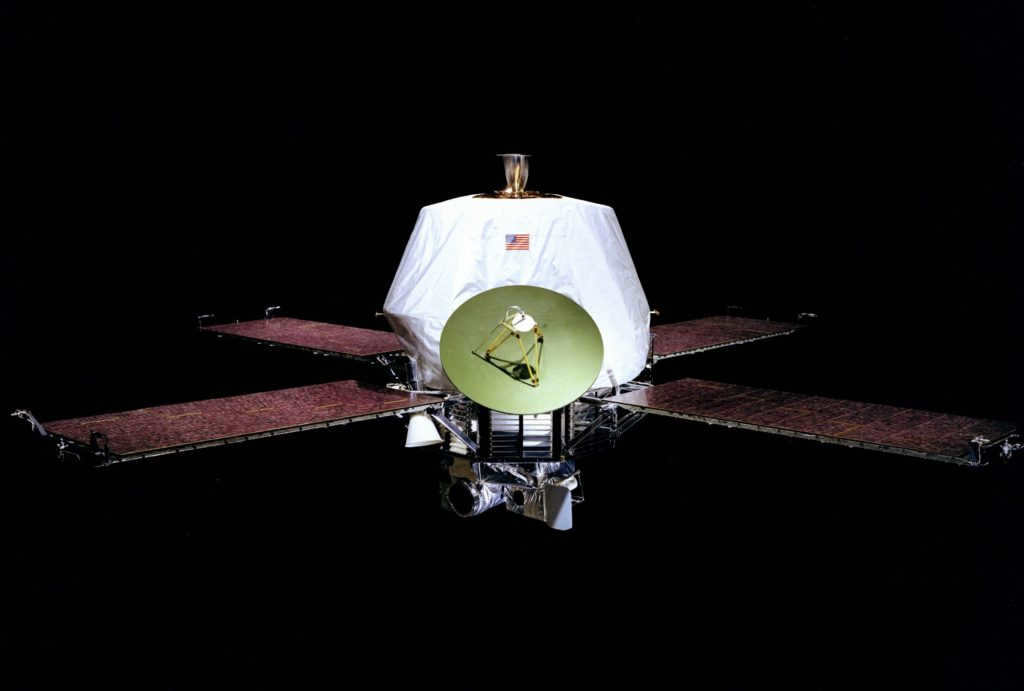
Fascinating fact: Phobos is an oblong monolith with nearly symmetrical proportions and stands at a towering height of 90 meters. The extent to which it has become embedded in the ground remains a mystery. It is speculated to be the remnants of a meteorite.
During an endeavor to explore Mars and its satellites in 1988 using two Phobos interplanetary stations, one of the spacecrafts was lost just 2 months after its launch. The remaining probe conducted a portion of the research and transmitted the findings back to Earth, but communication was abruptly severed.
The initial stereoscopic images were captured on January 9, 2011, thanks to the ongoing operation of the Mars Express station. These images were taken from a vantage point 100 km away, with a remarkable resolution of 16 meters.
By 2025, there are plans to launch the interplanetary stations MMX and Phobos-Grunt 2. However, even now, valuable information about the soil can be gathered using vehicles operating in Mars’ orbit. Observations are being conducted in the infrared range to measure the cooling and heating rates of Phobos’ surface. These measurements will help determine the soil’s properties and provide an estimate of its composition.
Through the analysis of the collected data, it has been determined that the maximum temperature on the satellite reaches 27℃, while the minimum temperature drops to -123℃. These findings suggest that the upper layers of Phobos’ structure are uniform, with basaltic rocks potentially making up a significant portion of the soil.
Observing the Martian Landscape
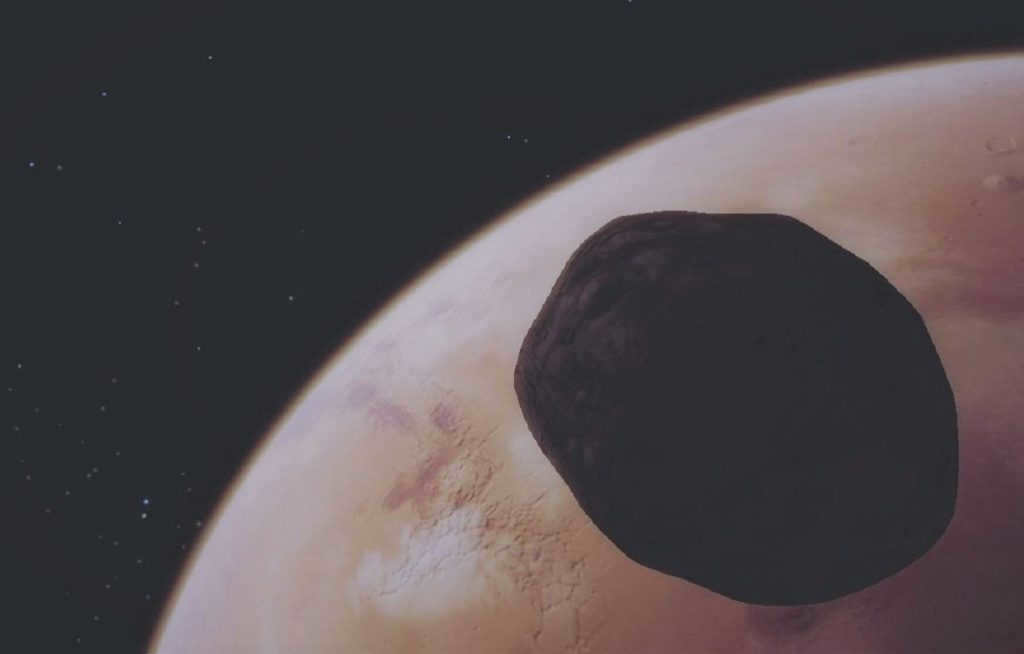
When Phobos is observed from Mars, its apparent size will be one-third that of the full Moon. The satellite’s brightness is sufficient to cast shadows on objects on the planet’s surface. Due to its rapid motion, Phobos rises and sets twice a day in the Martian sky. On the surface of Phobos, the distinct features of the large Stickney crater can be easily distinguished.
Phobos frequently crosses the solar disk, a phenomenon that was captured on camera by the Opportunity rover. During this transit, which lasts only 30 seconds, the satellite obscures a significant portion of the Sun, while its shadow passes over Mars.
Here are the key characteristics of Phobos:
- Size: 26.8×22.4×18.4 km;
- Semi-major axis: 9380 kilometers;
- Orbital period: 0.3189 days;
- Rotation period: 0.3189 days;
- First space velocity: 0.08 km/s;
- Second space velocity: 0.0103;
- Albedo: 0.07;
- Inclination to the equator of Mars: 1.1 degrees;
- Average density: 1.9 g/cm3.
Names of Craters
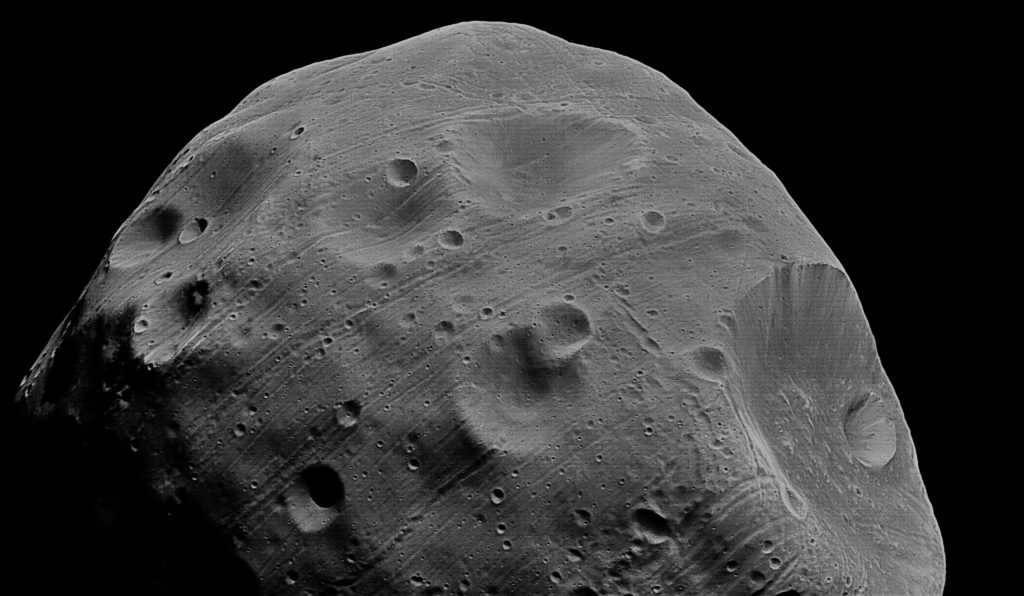
The surface of Phobos is adorned with numerous craters. Among them, the largest one is known as Stickney, which was named after Asaph Hall’s wife. Asaph Hall was the astronomer who discovered the Martian satellites. Stickney crater covers about one-third of the entire satellite and spans a distance of 9 kilometers. Inside this massive crater, there is a smaller one called Limtok, which was named after a character from the famous book “Gulliver’s Travels.” Moving on to other craters, we have the Hall crater, which measures 6 kilometers in diameter, with 5 kilometers occupied by the Roche crater. These craters were named after renowned astronomers. Additionally, we have a series of smaller craters named D’Arre, Epic, Sharpless, Shklovsky, Todd, and Wendell.
Interestingly, seven craters on Phobos have been named after characters from Jonathan Swift’s book “Gulliver’s Travels.” These craters include Gulliver, Clustril, Drunlo, Flimnap, Grildrig, Reldresal, and Skyresh. However, there are still some insignificant craters that remain unnamed.
Anticipated devastation
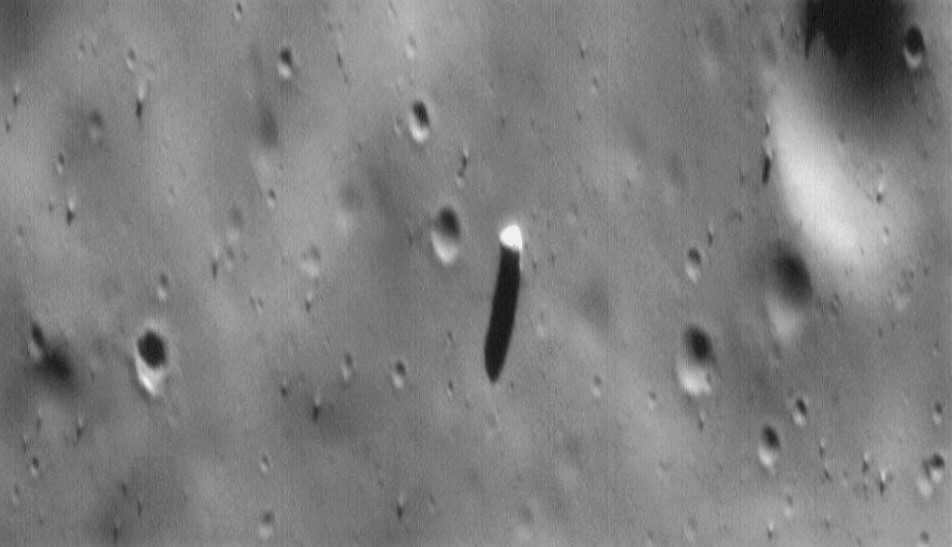
Scientists have determined that Phobos, the moon of Mars, is slowly approaching the planet due to its decreasing orbit radius. This phenomenon suggests that Phobos is likely to be destroyed in the near future, estimated to be within the next 30-50 million years. The moon’s gravitational attraction to Mars will ultimately cause it to either crash onto the planet’s surface or break apart into smaller pieces.
Across the entire expanse of the satellite, there are smooth furrows and chains of small craters that run parallel and perpendicular to each other. These markings are believed to be the result of space debris and meteorites. It almost resembles the seams of a collapsing framework, especially when considering the theory that the Martian moons have artificial origins.
The peculiar thing about the discovery of Phobos and Deimos is that they were only found relatively late, considering that the technology in 1877 was advanced enough for humans to have located the satellites earlier. Astronomer I.S. Shklovsky proposed that they were possibly of recent origin and potentially artificial.
In 1989, the Phobos-2 station revealed the hollow structure of one third of the satellite. Additionally, the MARSIS radar complex utilized radio waves to observe that the voids possess geometric shapes, rather than being arbitrary.
Predicting the trajectories of a pair of satellites

In 1611, the existence of two satellites orbiting Mars was first mentioned by Johannes Kepler, a German mathematician and astronomer. Kepler was able to decipher an anagram by Galileo Galilei which read, “Hail to you, twins, Mars is the spawn of Mars.” However, Kepler’s interpretation was incorrect. In reality, Galileo Galilei was referring to his observations of Saturn and its rings.
In 1726, J. Swift’s “Gulliver’s Travels” was published, featuring a chapter that mentioned astronomers discovering two satellites in Mars’ orbit.
Failed attempt to reach the satellite
On November 9, 2011, a new mission called Phobos-Grunt was launched. The main objectives of this space expedition were to collect and transport soil samples from the Martian satellite back to Earth. However, instead of following its intended path, the spacecraft experienced a program malfunction and ended up crashing into the Pacific Ocean on January 15, 2012. As a result of this failure, a second mission, “Phobos-Grunt 2,” has been scheduled for 2025.
If you discover an error, please select the text and press Ctrl+Enter.
Phobos, one of the two moons of Mars, has been extensively studied. At first glance, it may appear to be just another large rock, similar to the many found in the asteroid belt. However, Phobos is actually a unique object with its own distinct characteristics. Like any other planet or moon, it possesses its own fascinating qualities.
Mars has two moons, Phobos and Deimos, which are named after the Greek words for “Fear” and “Terror.” These names are fitting descriptions for these celestial bodies.
The Unveiling of Phobos, a Martian Moon
In the realm of celestial bodies, it was the eminent American astronomer Asaph Hall who made an astounding breakthrough on August 18, 1877, as he stumbled upon not just one, but two satellites orbiting Mars. These remarkable findings were later christened Phobos and Deimos, thanks to the creative mind of Henry James Madan. Hall readily agreed with the suggestions and six months following the remarkable discovery, these enigmatic moons were officially given their celestial names, drawing inspiration from the illustrious work of Homer’s Iliad.
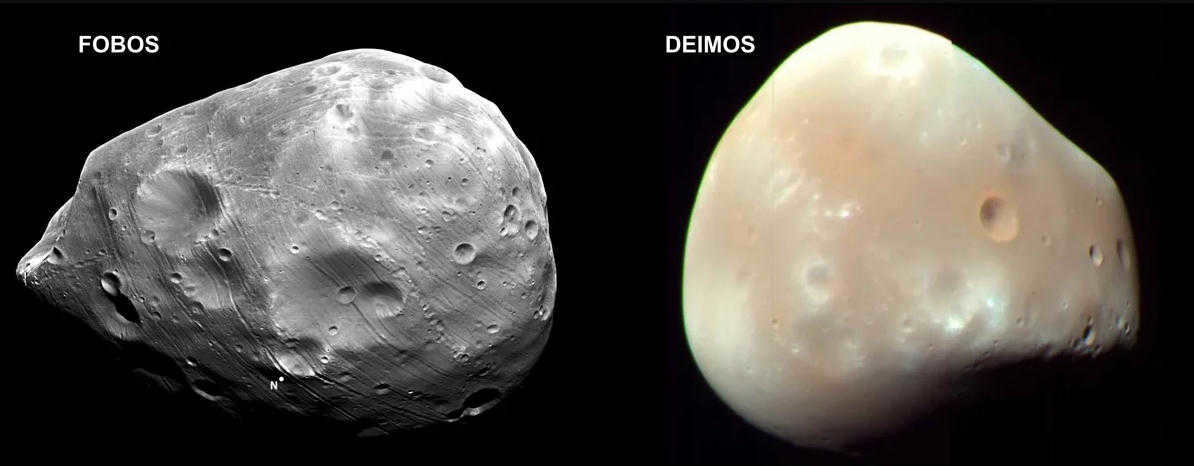
The two moons of Mars are known as Phobos and Deimos.
Efforts to locate the satellites of Mars have been made in the past. Nearly a century prior to their discovery, in 1783, William Herschel attempted to find them without success. These attempts persisted, but were ultimately unsuccessful.
What’s even more intriguing is that few doubted the existence of a pair of satellites around Mars. In fact, as early as 1611, Kepler proposed that Galileo Galilei had observed them. Of course, Kepler’s assumption was incorrect – Galileo Galilei had actually observed Saturn and mistakenly believed its rings to be a triple planet, which Kepler then attributed to Mars.
Moreover, our planet, Earth, possesses a solitary satellite, known as the Moon, while Jupiter is recognized to have 4 satellites. Consequently, astronomers logically deduced that Mars must possess two satellites. Astonishingly, this deduction proved to be accurate, although it is unquestionably a mere coincidence.
Furthermore, there exists another intriguing fact – in the renowned novel “Gulliver’s Travels” by Jonathan Swift, published in 1726, it is explicitly mentioned that the Lilliputians were already aware of the existence of the two satellites of Mars. Remarkably, this novel was penned 150 years prior to the actual discovery of these satellites. It is plausible that Swift relied on Kepler’s assertions for this information. However, he also provides certain orbital parameters that bear a striking resemblance to the actual ones.
Phobos, the closest satellite to Mars, has an average orbit distance of 9400 km, or 2.77 radii, from the planet’s center, which is only 6000 km from the surface. This distance is 41 times less than the Earth-Moon distance.
However, Phobos’ orbit is not perfectly circular. At its closest point, the distance between its center and Mars’ center is 9235.6 km, while at the farthest point, it is 9518.6 km. There is a small ellipticity in its orbit.
Due to its close proximity to the planet, Phobos has a rapid orbital period, completing a full revolution in just 7 hours and 39 minutes. In the Martian sky, it rises in the west and sets in the east every 11 hours, occurring twice a day. Additionally, it shines brightly like our Moon in the first quarter phase.
From the perspective of Mars, Phobos has a much faster movement across the sky compared to Deimos. Whenever they enter the shadow of the planet, an eclipse occurs. Although solar eclipses do occur, they are always of the annular type. The satellites of Mars are not large enough to completely block out the sun.
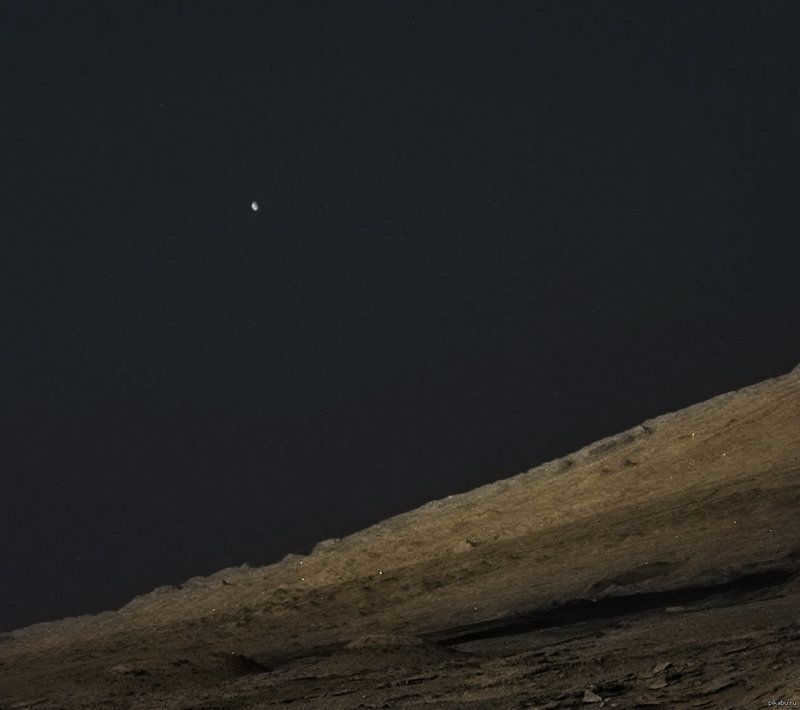

This is the appearance of Phobos when observed from the Martian surface.
Phobos is always tidally locked to Mars, meaning that one side always faces the planet. It is positioned in such close proximity to Mars that the gravitational pull from the planet effectively cancels out Phobos’ own gravitational force on the side facing Mars. As a result, it is not possible to place an artificial satellite into orbit around Phobos, as it would not be able to maintain a stable orbit and would instead drift away from the planet.
The composition and outer layer of Phobos
At first sight, this celestial body appears to be a massive boulder, similar to numerous asteroids. However, its density is remarkably low, measuring just 1.86 g/cm3. This low density indicates that Phobos is highly porous and contains numerous empty spaces. These voids are the reason why Phobos has managed to withstand the gravitational forces of Mars, despite its substantial size and relatively small mass.
Phobos boasts an irregular and elongated shape, with dimensions of 26.8×22.4×18.4 km. It constantly faces Mars along its longest axis.
Phobos is covered with numerous craters, but the most notable one is the Stickney crater, which has a diameter of 9 km. Despite being located on a relatively small satellite, it is truly impressive. Within the Stickney crater lies another impact crater called Limtok, which measures 2 km in diameter. Interestingly, the Stickney crater is named after Asaph Hall’s wife, who discovered the moons of Mars. This crater is estimated to be around one million years old. Surrounding the edges of the Stickney crater are peculiar furrows whose origin still remains a mystery.

The largest crater on the surface of Phobos, known as Stickney, measures 9 km in cross-section. Inside this crater, there is a smaller crater called Limtok, which has a diameter of 2 km.
The Origin of Phobos
There are various theories regarding the formation of Phobos, Mars’ natural satellite, but none of them have been definitively proven. Due to its similarities to the numerous asteroids found in the nearby asteroid belt, it is reasonable to speculate that Phobos simply passed by Mars and was subsequently captured by its gravitational pull.
However, this theory does have its flaws. It is unlikely that Mars would have captured two asteroids simultaneously, and both Phobos and Deimos exhibit a porosity that is uncommon among typical asteroids. Additionally, the gravitational forces exerted by Mars would likely result in the destruction of the asteroids rather than their capture. There are other inconsistencies as well.
Hence, a theory exists suggesting that Phobos and Deimos were once a single asteroid that split in two when it was captured by Mars. However, even this explanation has its limitations.
Moreover, another hypothesis proposes that during the early stages of the solar system, Mars collided with a planetesimal, which were abundant at that time. This collision resulted in a significant amount of matter being ejected into space, eventually forming Phobos and Deimos. Interestingly, a similar theory also exists regarding the origin of the Moon.
The destiny of Phobos
According to scientists, Phobos, the moon of Mars, has a rather short lifespan in cosmic terms. It is predicted that after 10 million years, it will undergo severe tidal forces from Mars, eventually resulting in its disintegration and the formation of a ring around the planet. The fragments will eventually descend onto the Martian surface, and within 43 million years, Phobos will no longer exist.
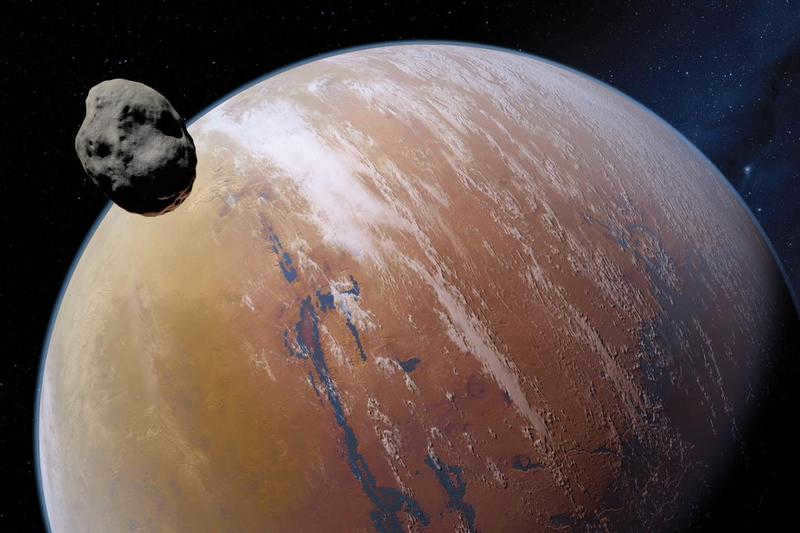
The truth is that Phobos has been in a risky situation for a while now and is getting closer to Mars at a rate of almost 2 meters per century. It may not seem like much, but this process is getting faster – the closer Phobos gets to the planet, the quicker the approach becomes. This is because of the gravitational force of Mars – it slows down the satellite and causes its orbit to decrease. Once it reaches its Roche limit, it will break apart. Currently, its porous structure is the only thing keeping it together, but this won’t last much longer.
Studying such a small satellite is undoubtedly a challenging task when using telescopes. Consequently, all the fundamental details about Phobos and Deimos were obtained through space probes. The initial probe to gather information was the American Mariner 9 in 1971, followed by two Vikings in 1977.
Afterward, there was a significant hiatus, and it was only since 1998 that Mars exploration missions have managed to acquire extensive data about its moons. Stations like Mars Global Surveyor, Mars Express, and Mars Reconnaissance Orbiter operated in the planet’s orbit. For instance, Mars Express captured highly detailed photographs of Phobos with a remarkable resolution of only 16 meters.
There were also unsuccessful endeavors, such as Russia’s 2011 Phobos-Grunt mission, which had the specific goal of exploring Phobos and bringing back soil samples to Earth. However, due to a software malfunction, the probe ended up plunging into the Pacific Ocean.
There are plans for a mission called Martian Moons Exploration in 2024, which is similar to a Japanese mission. The mission aims to deliver Phobos soil to Earth. The outcome of this mission will be revealed in the near future.
Phobos is a small moon that orbits Mars. Its surface is covered with crater formations. Scientists believe that the moon is in danger of destruction.
Phobos is the larger of the two moons of Mars, measuring 27 km x 22 km x 18 km. It completes three rotations around Mars in one day.

As each century passes, the planet gets 1.8 meters closer, which means that in 50 million years it will either collide with Mars or be ripped apart by the gravitational force during its approach.
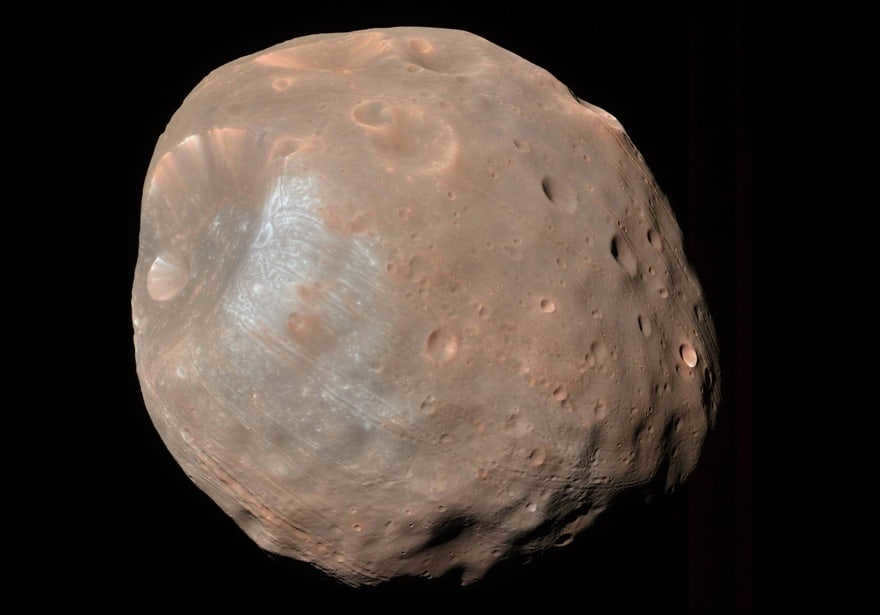
A photograph captured by the Mars Reconnaissance Orbiter (MRO) in 2008 displays a vibrant color image of Phobos.
Scientists theorize that the Martian moons, including Phobos, consist primarily of C-type material, which bears a resemblance to dark carbonaceous chondritic asteroids. Extensive research conducted by the Mars Global Surveyor has revealed that the surface of Phobos has been pulverized into a fine powder over countless years of meteorite impacts. As a result, this pulverization has triggered landslides and the formation of dark trails – steep slopes found within large craters.

The panel displays the gradual movement of the Martian moon Phobos as it crosses in front of the Sun. Generated from matched footage captured by the Opportunity rover on the 45th Martian sol. Observations of this nature contribute to our understanding of Phobos’ orbit and position. This occurrence is reminiscent of a solar eclipse, where the Moon passes in front of the star. The rover’s panoramic camera was utilized to capture these images.
Measurements taken on the day and night sides reveal significant fluctuations in temperature. The daytime temperature reaches a maximum of -4°C, then drops to -112°C during the latter half. This rapid cooling is attributed to the presence of fine surface dust that lacks heat retention capabilities.
A skilled tarot reader will provide answers to the following inquiries:
What does the future hold for you? How will your relationships progress? Which decision should you make?

The Phobos satellite and its origin
Phobos, the satellite of Mars, does not have an atmosphere and it is believed that it may have been captured by an asteroid.
The discovery of Phobos
On August 17, 1877, an asteroid was spotted by Asaph Hall, which turned out to be the Phobos satellite.
The naming of Phobos
Both of Mars’ satellites were named after the sons of Ares, the Greek god of war. The name Phobos represents fear. Take a look at the map of the Phobos satellite’s surface below.
Now you know that Phobos is a satellite of the planet Mars.
The primary characteristics of the Phobos satellite
Map of the surface of the Phobos satellite
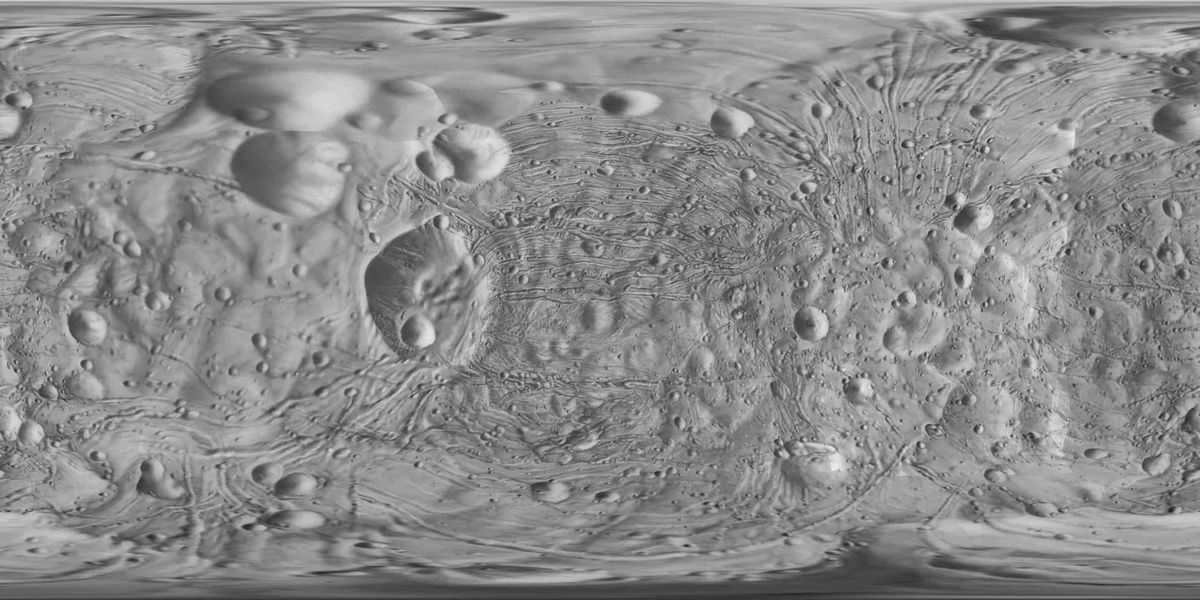

Feel free to click on the picture for a larger view.
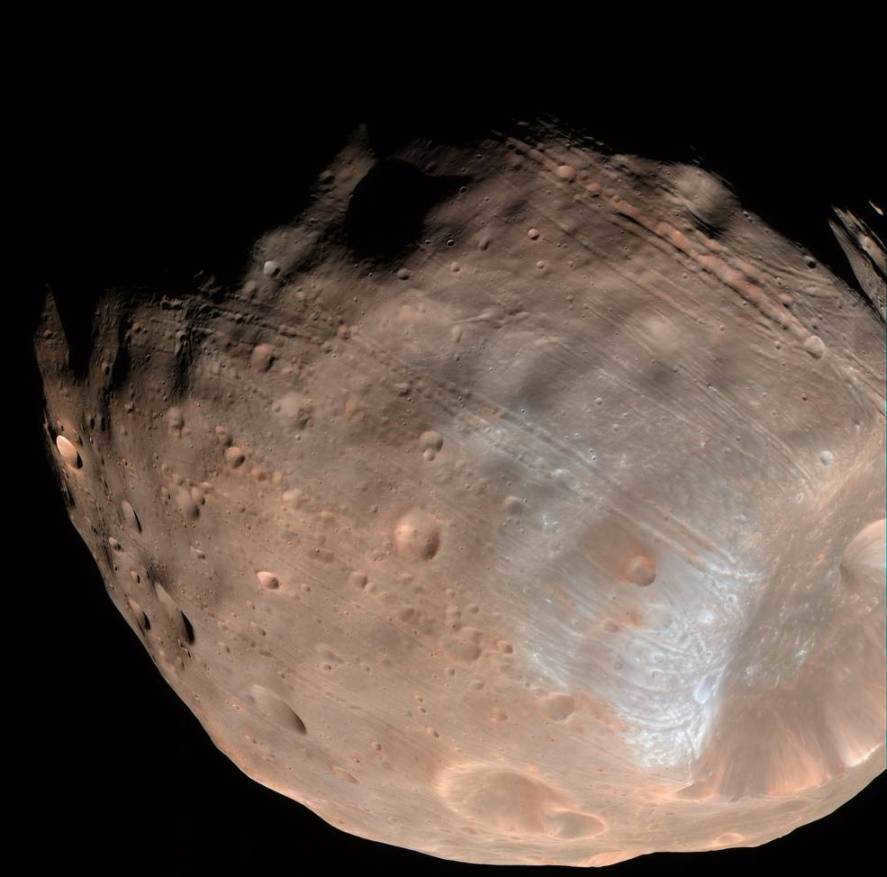
Phobos – The Martian satellite: a detailed overview for children with accompanying images, covering its mass, size, interesting facts, distance from Mars, formation process, origin of its name, myths surrounding it, composition, surface features, and its notable crater.
Key Information about the Phobos Satellite – Explained for Kids
- Radius: 11.1 km.
- Distance from the center of Mars: 9,376 km.
- Closest approach to Mars: 9,234 km.
- Maximum distance from Mars: 9,518 km.
- Eccentricity of its orbit: 0.0151.
- Orbital inclination: 1.075 degrees.
- Time taken to complete one orbit: 7.65 hours.
- Mass: 1.0659 x 10^16 kg.
- Density: 1.872 g/cm^3.
- Surface density: 0.0057 m/s^2.
- Recoil velocity: 41 km/h.
For young children, it may be fascinating to learn that the Martian moon Phobos is situated a few thousand miles above the surface of the planet. However, it is important for adults or educators to clarify to youngsters that this proximity poses a significant risk. Over time, the moon is gradually drawing nearer and nearer, and eventually, it will collide with or disintegrate due to gravitational forces.
The discovery and naming of the moon Phobos – a simplified explanation for kids
Let’s start our simplified explanation for kids with Johannes Kepler. This was a scientist from Germany who lived in the 17th century. He had a theory that there might be two moons going around Mars. But he came up with this idea using math, not by actually seeing the moons. At that time, people knew about moons going around other planets (like Earth and Jupiter), but they didn’t have any solid proof for Mars having any moons. However, an American astronomer named Asaph Hall was determined to find out if Mars was really “lonely” or not. He carefully observed the sky and got closer and closer to the planet.
He was greatly frustrated by his unsuccessful attempts and decided to quit. However, his wife Angelina was determined not to let him give up. On the very next night (August 12, 1877), he discovered Deimos, and just 6 days later he found Phobos. The distance between these satellites and the planet was so small that they were able to hide in its light. Due to their small size, they are considered the smallest moons in our solar system (Phobos is 7.24 times larger than Deimos).
These satellites were named after characters from Greek mythology. Phobos was the son of Ares, the god of war (known as Mars in Roman mythology). Phobos means “fear” and Deimos means “flight” (particularly in the context of escape).
Children need to understand that the study of satellites has been ongoing for centuries. The initial satellite to enter the orbit of Mars was Mariner 9 in 1971. Additionally, it was the pioneer in successfully establishing a presence in the orbit of a foreign planet. The images it captured revealed that Phobos and Deimos had an irregular shape resembling potatoes, rather than the typical spherical form of most satellites. Phobos was particularly challenging to observe due to tidal locking, which means that one side always faces the planet.
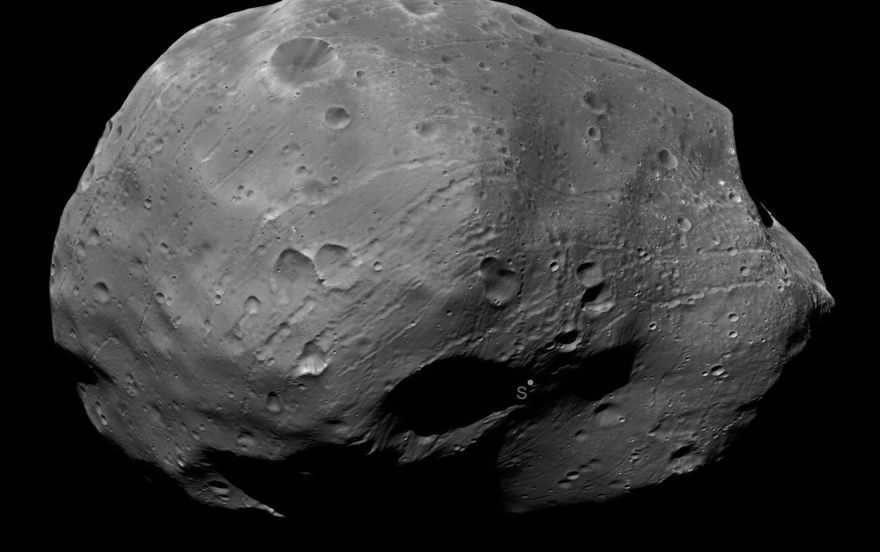

This photograph captures Phobos, one of Mars’ two moons, as seen from a distance of 6,800 kilometers. The image was taken by the Mars Reconnaissance Orbiter, a spacecraft that has been instrumental in unraveling the mysteries of these satellites. Over the years, several other missions have contributed to our understanding of Phobos, including the Viking, Phobos-2, Mars Global Surveyor, and Mars Express missions. Additionally, the surface rovers Spirit, Opportunity, and Curiosity have provided valuable data. NASA’s MAVEN mission has also been studying Phobos to gain insights into its composition.
For the younger generation It’s worth noting that in 2011, Russia made an attempt to launch the Phobos-Grunt spacecraft to the moon, with the intention of bringing back a sample in 2014. However, due to technical issues with the rocket, the spacecraft crashed into the Pacific Ocean in 2012.
NASA, on the other hand, is not giving up on their research efforts. There are discussions about the Phobos Servator mission, which aims to send multiple probes to the surface of the moon. Another mission called Discovery is also being considered, which would explore both Phobos and its companion moon. The PADME spacecraft will play a crucial role in determining their origins. If this project is chosen, it could be ready by 2020.
Some have even proposed a human mission to Phobos, and NASA hopes to make this a reality by the 2030s.
The creation and makeup of the Phobos moon – a simplified explanation for kids
It’s crucial to help children understand that studying the inside of Phobos provides us with valuable information beyond just its appearance. Both moons have a somber gray color and are covered in impact craters. They are among the least reflective objects in our solar system.
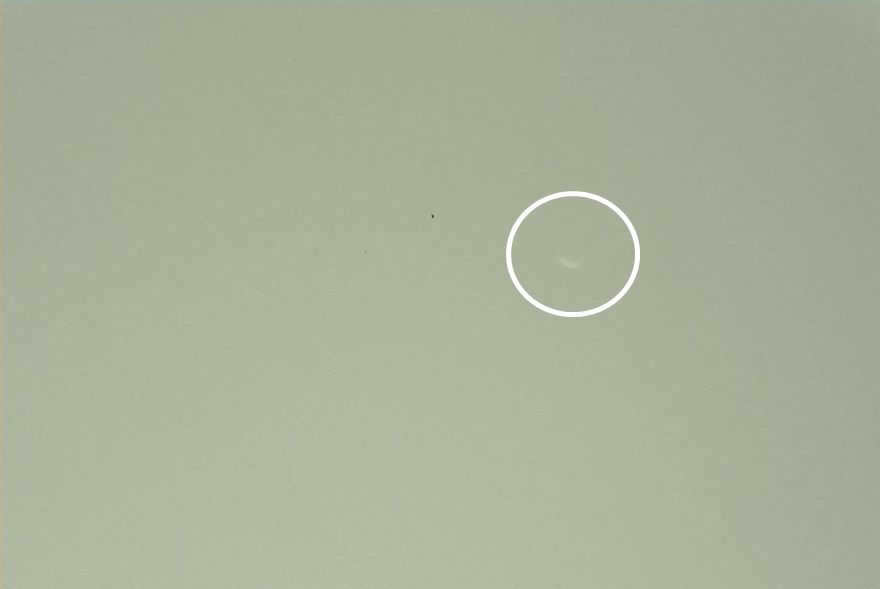

Phobos is the bigger moon of Mars, measuring 14 miles in diameter. The photograph was taken by the Curiosity spacecraft and published on September 26, 2014.
Scientists have concluded that the moons were created from material resembling Type I or II carbonaceous chondrites (found in asteroids and dwarf planets). Due to their shape and composition, researchers believed the moons originated from the Asteroid Belt (they were ejected by Jupiter’s gravity).
There are several possible explanations for the origin of the Martian moons. One hypothesis suggests that they may have formed when rocks and dust merged due to the influence of gravity. Another possibility is that they were created as a result of a collision with a large object. In this scenario, the fragments from the impact could have come together to form satellites. Alternatively, it is also speculated that there may have been a single moon that eventually split into the two moons we see today, Deimos and Phobos.
It is important to emphasize to young children that it is not accurate to confuse reality with science fiction. In movies, moons are often depicted as being much larger in size compared to their planetary counterparts. However, Phobos is actually only about one-third the width of Earth’s moon.
The Inevitable Fate of Phobos – A Simplified Explanation for Kids
Your parents or your teachers at school might have told you that Phobos, one of Mars’ moons, won’t be able to orbit around the planet forever. This is because Phobos is slowly getting closer to Mars at a rate of 1.8 centimeters every 100 years. In about 50 million years, Phobos will either crash into the surface of Mars or be torn apart by the planet’s powerful gravitational forces, resulting in the formation of a ring around Mars.
Due to its unique characteristics, some scientists initially questioned whether Phobos was actually a natural moon or if it had a different cosmic origin. One of the scientists who proposed this idea even served as a science advisor to President Dwight D. Eisenhower. However, further research has since confirmed that Phobos did indeed form naturally.
An Explanation for Children: The Surface of the Satellite Phobos
Phobos, a satellite, has a diameter of 17-22 kilometers. The surface of Phobos is covered with a layer of dust, approximately 1 meter thick. Scientists believe that this layer of dust is the result of a meteorite attack. On the surface of Phobos, there is a massive crater called Stickney crater, which has a diameter of 9.5 kilometers. The impact that created Stickney crater also caused secondary impacts as rocks fell to the surface. It may interest young children to know that the crater is named after Hall’s wife, who had the maiden name Stickney.
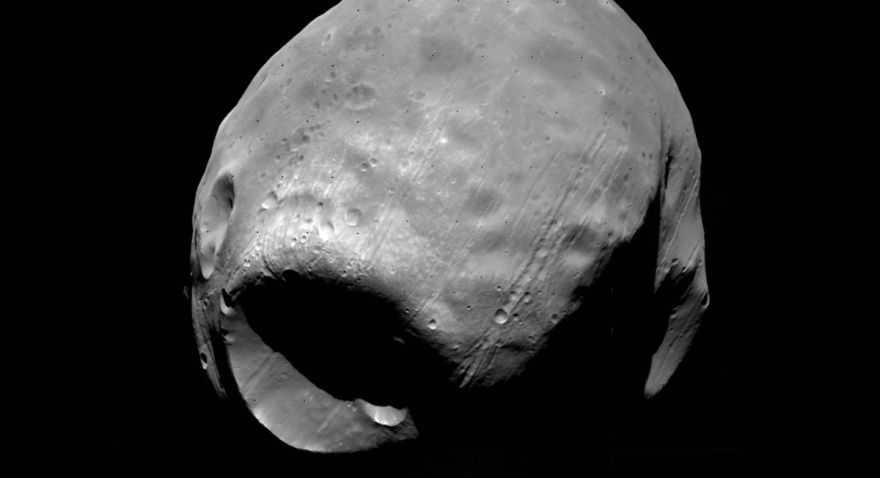
Phobos, the moon of Mars, is characterized by the presence of extensive grooves on its surface. Recent research conducted in 2015 suggests that these grooves are a result of tidal forces caused by the gravitational pull of Mars. However, an alternative hypothesis proposes that they are remnants of a large-scale impact that formed Stickney Crater. Additionally, a study from 2014 suggests that the grooves may be composed of material that originated from Mars.
The temperature on Phobos exhibits drastic variations throughout the day, ranging from -4°C to -112°C.
We hope that the information regarding Phobos, the satellite of Mars, has been of great value to you. When explaining this to children, it is important to provide them with captivating facts, fascinating photos, engaging videos, and vivid illustrations to ensure that the learning experience is as comprehensible as possible. Additionally, children of all ages will surely be enthralled by our remarkable 3D model of the solar system, which provides intricate details of Mars’ topography, surface characteristics, and accompanying satellites. While some individuals claim to have witnessed Phobos through an online telescope in real time, this is highly unlikely due to the vast distance separating it from Earth and its relatively small size, making it arduous to observe.
Expand your knowledge on the satellites of Mars:
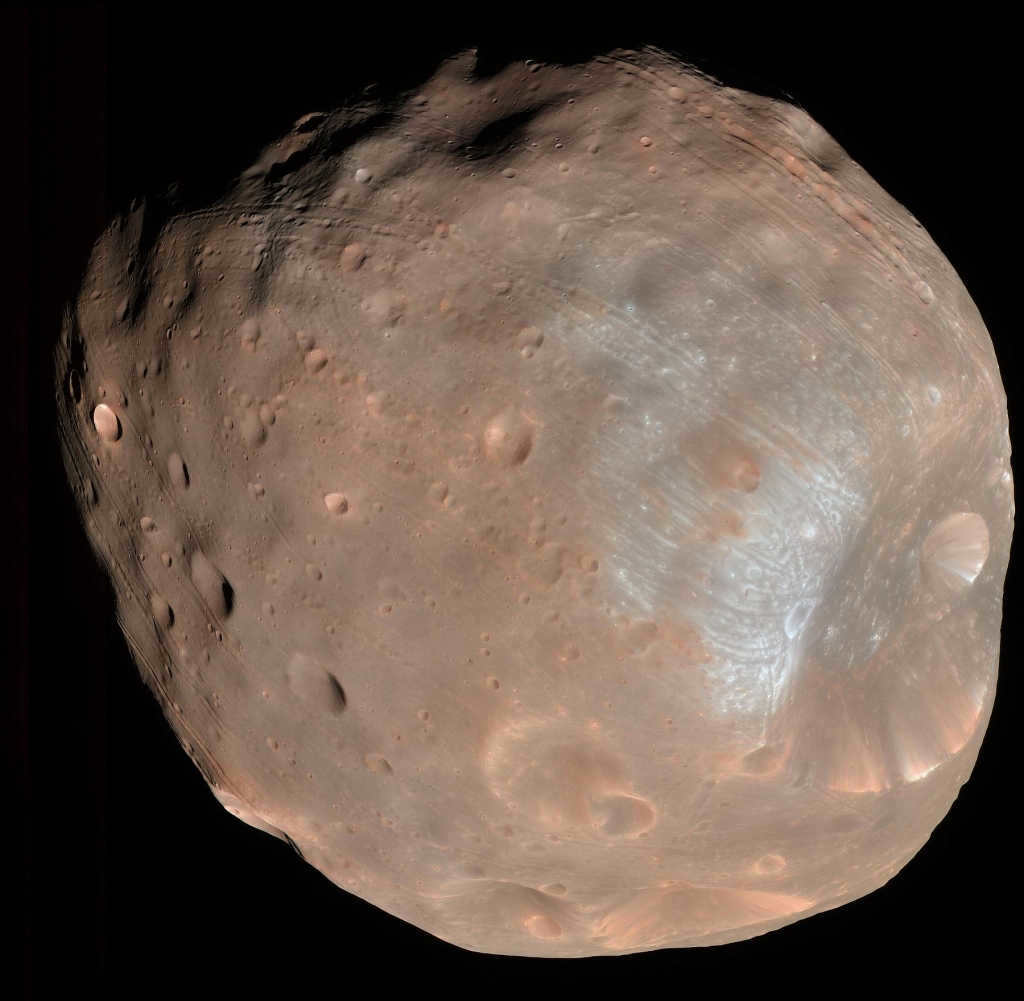
The average diameter of Phobos, the closest satellite to Mars, is 22.2 km, while its measurements are 27 × 22 × 18 km. Despite its small size, Phobos is not perfectly round.
Physical characteristics
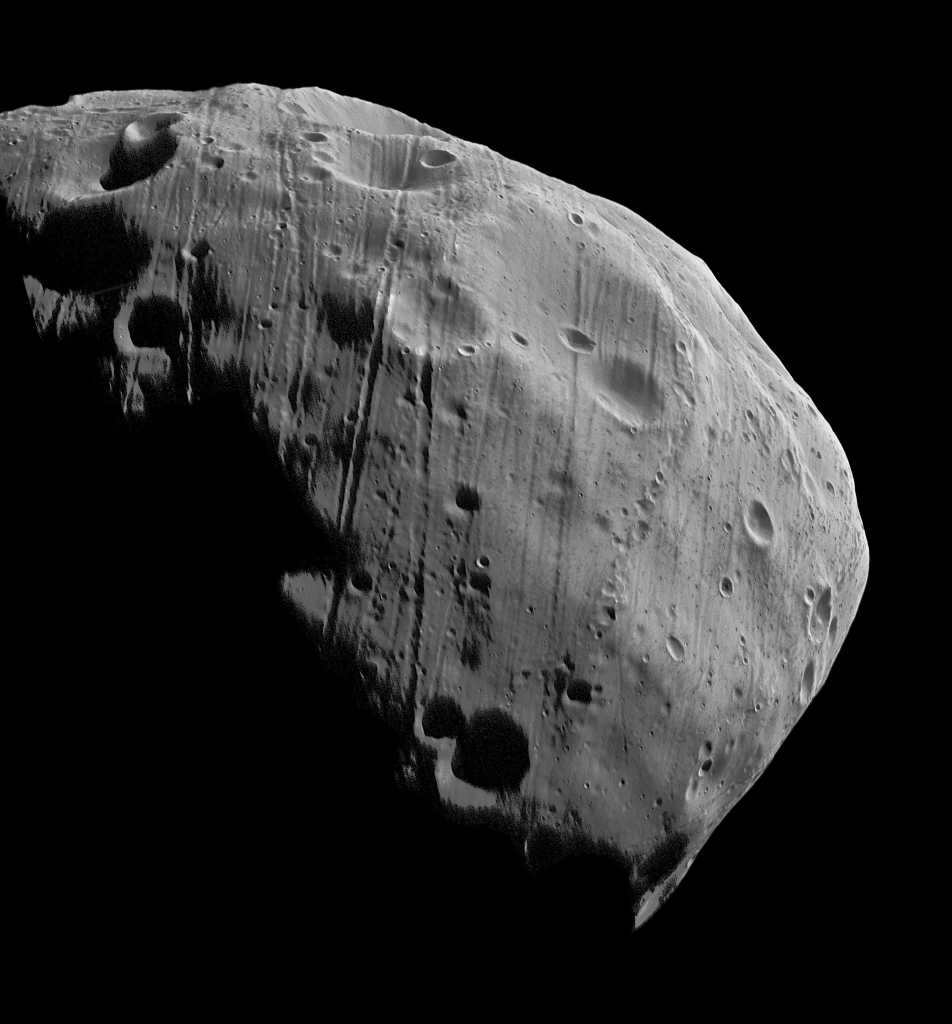

An image of Phobos, the satellite of Mars, was captured by the Mars Express spacecraft on July 23, 2008, from a distance of 93 kilometers.
The distance between Mars and Phobos is 9,377 kilometers. The initial velocity of Phobos in space is only 7 m/s. Its size is slightly smaller than that of a city with a population of approximately 1 million people. Phobos does not have an atmosphere due to its low gravity caused by its small mass. It is one of the least reflective objects in the entire solar system.
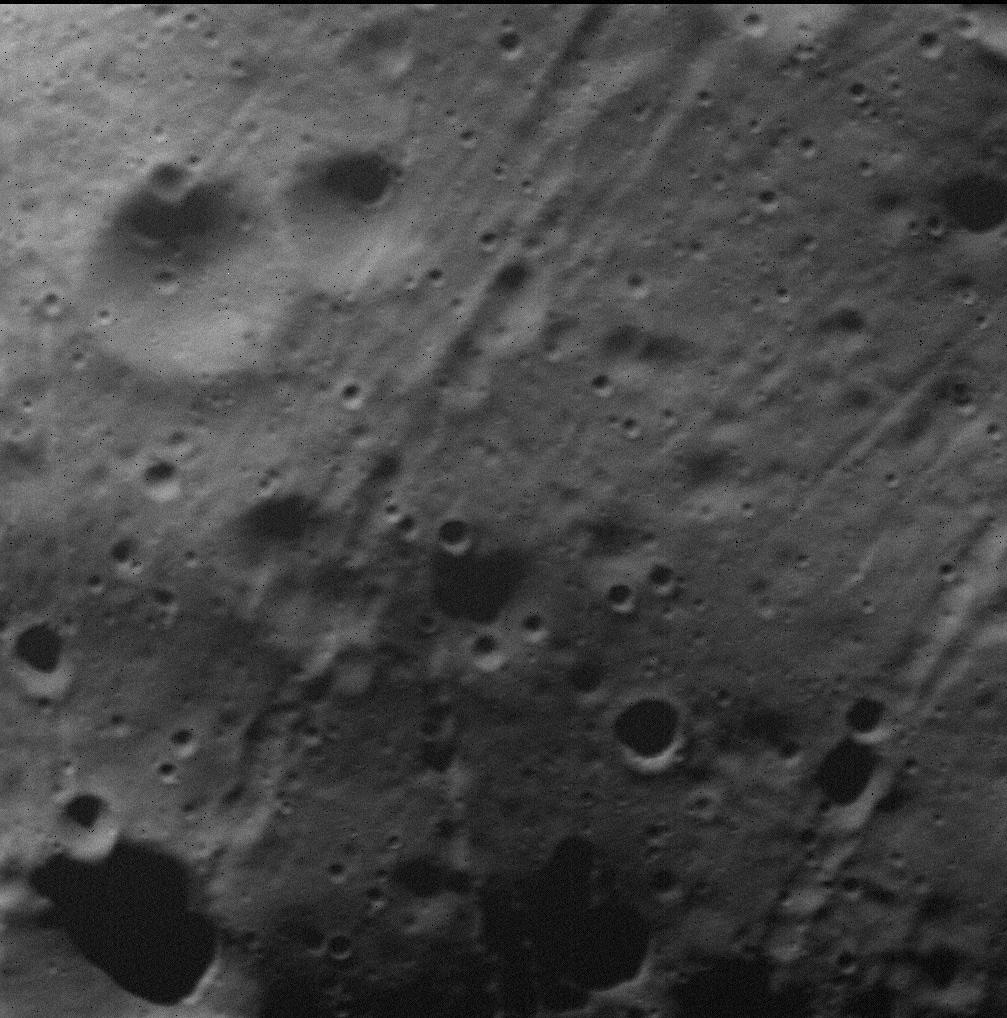
The image captured by the ESA Mars Express spacecraft shows the surface of Phobos, the satellite of Mars, from a distance of 500 km.
Phobos, with its spectroscopic similarity to D-type asteroids and chemical composition resembling carbonaceous chondrites, is believed to have a low density and significant porosity, indicating that it may not be a solid body. These characteristics have led scientists to speculate that Phobos could potentially harbor substantial reserves of ice.
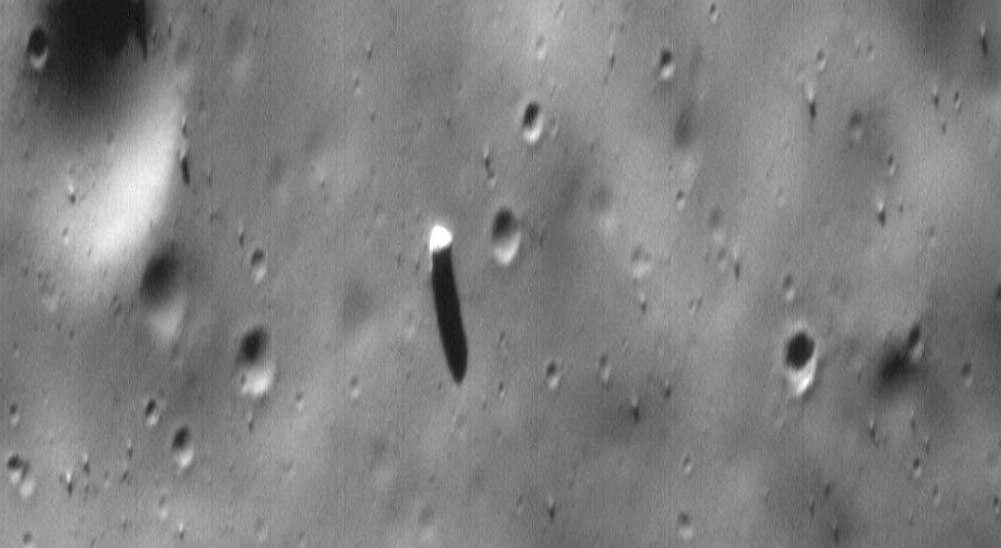
There are enormous rock formations on the surface of Mars’ nearest moon called Phobos.
Based on spectral observations, it is evident that the regolith, which is the top layer of the moon’s surface, does not contain water, although the possibility of its presence below cannot be ruled out. The surface temperature of Phobos is recorded to be 233 degrees Kelvin. The satellite has a gray color, as depicted in photographs taken by various space vehicles.
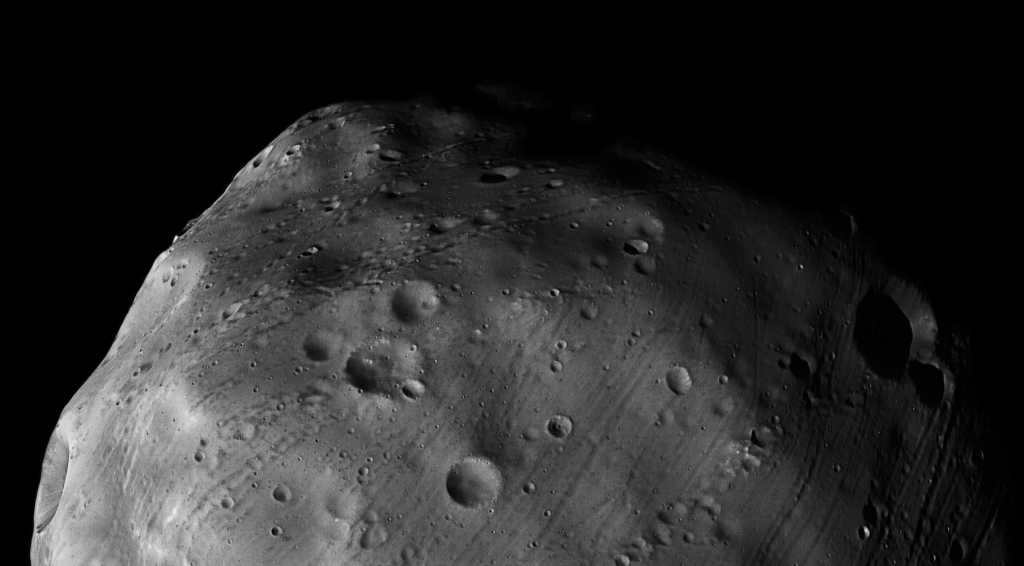
The surface of Phobos, one of Mars’ moons, is heavily pockmarked with craters. The largest of these craters is called Stickney, which was named after Asaph Hall’s wife. Similar to Mimas, one of Saturn’s moons that features a massive Herschel crater, the impact that formed the Stickney crater likely caused extensive damage to Phobos. The remnants of this impact can be seen in the form of grooves and streaks on the moon’s surface, which are the result of material being ejected during the collision. These grooves are relatively shallow, measuring less than 30 meters in depth, and range in width from 100 to 200 meters. Some of these grooves can stretch up to 20 kilometers (12 miles) in length.
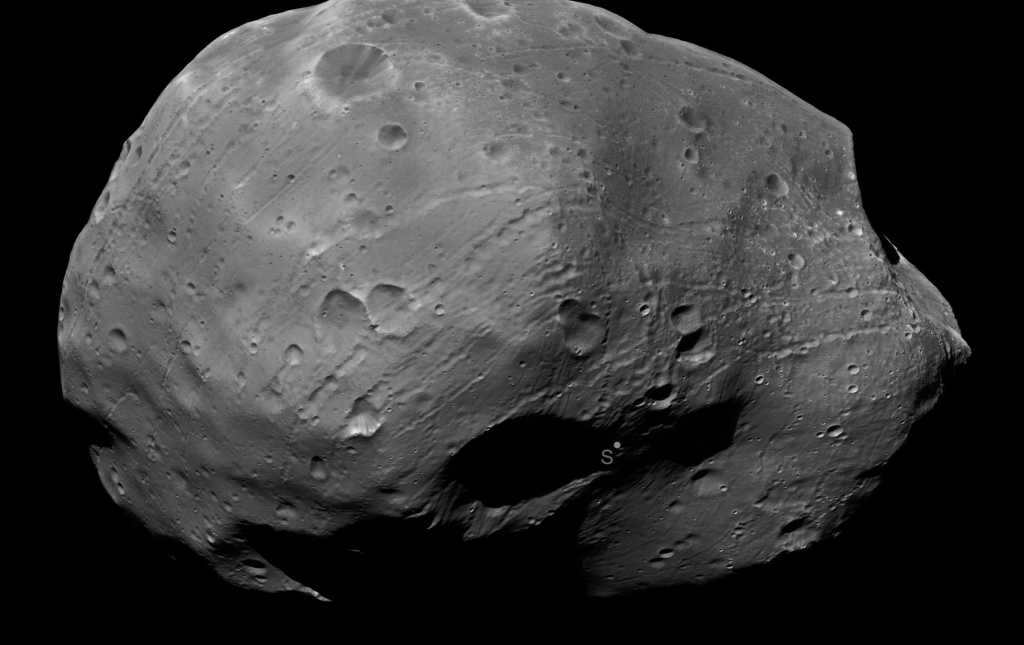
On January 9, 2011, the Mars Express came within a mere 111 kilometers of Phobos.
For a while now, scientists have theorized about the existence of faint dust rings surrounding Phobos and Deimos, but all attempts to locate them have been unsuccessful. Recent images reveal that Phobos is covered in a layer of fine-grained regolith, at least 100 meters thick, which is believed to have been formed through collisions with other celestial bodies. However, it remains a mystery as to how this material managed to cling onto the surface of a celestial body with minimal gravity.
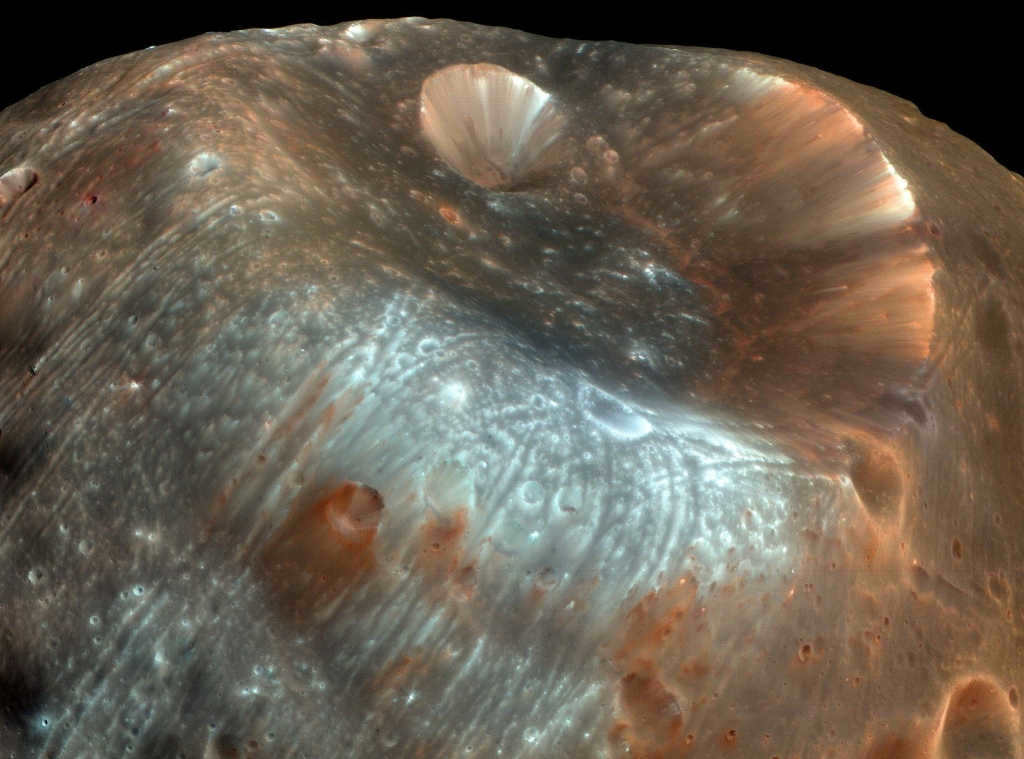
Enhanced for contrast, this is one of the finest photographs available.
The geological characteristics found on Phobos have been given names in honor of the astronomers who dedicated their studies to it, as well as the individuals and locations from Jonathan Swift’s famous novel, Gulliver’s Travels.
| Crater | Named after |
| Clustril | A character from the novel Gulliver’s Travels |
| D’Arré | Henry Louis d’Arré, an astronomer |
| Drunlo | A character from Jonathan Swift’s Gulliver’s Travels |
| Flimnap | A character from the book Gulliver’s Travels |
| Grildrig | A character featured in Gulliver’s Travels |
| Gulliver | The main character of the novel Gulliver’s Travels |
| Hall | Asaph Hall, the astronomer who discovered Phobos |
| Limtoc | A fictional character from Gulliver’s Travels |
| Epic | Ernst J. Epic, an astronomer |
| Reldresal | A character mentioned in Gulliver’s Travels |
| Roche | Edouard Roche, an astronomer |
| Sharpless | Bevan Sharpless, an astronomer |
| Shklovsky | Iosif Shklovsky, an astronomer |
| Skyresh | A fictional character from Gulliver’s Travels |
| Stickney | Angelina Stickney, the wife of Asaph Hall |
| Todd | David Peck Todd, an astronomer |
| Wendell | Oliver Wendell, an astronomer |
Modifications in the brightness of Phobos as it crosses the celestial sphere
Phobos is currently recognized as the most extensively studied natural satellite in the solar system, following the Moon.
Its close orbit around its parent planet generates some remarkable orbital effects.
Being at an elevation of 9377 kilometers from the surface, Phobos orbits around Mars below the radius of the synchronous orbit, implying that it moves around Mars more rapidly than the planet itself rotates around its axis.
Phobos transits across the disk of Mars (top right position). Perspective from an altitude of 66.275 kilometers. Captured by India’s MOM probe
Therefore, when seen from the surface, the sun appears to rise in the West and make a relatively fast journey across the sky, taking about 4 hours and 15 minutes before setting in the East. This pattern repeats twice during each Martian day, which is equivalent to about 11 hours and 6 minutes. However, due to its proximity to the surface, the sun cannot be seen above the horizon at latitudes greater than 70.4 degrees. Additionally, the sun’s angular diameter varies significantly depending on its position in the sky, as a result of its low orbit.
Angular measurements

Phobos descends below the Martian horizon as evening falls. Mount Sharp can be seen on the right.
During the Rosetta flyby in 2007, Phobos set behind the disk of Mars.
At the horizon, Phobos appears about 0.14 degrees in diameter, while at the zenith it is about 0.20 degrees, making it approximately one-third the size of a full Moon. In comparison, the Sun has an angular size of about 0.35 degrees in the Martian sky.
From the surface of Phobos itself, Mars appears 6400 times larger and 2500 times brighter than the full Moon in Earth’s sky. In the Mars-Phobos system, the Lagrangian point L1 is located 2.5 km above Stickney Crater, which is very close to the surface.

The movement of Phobos across the center of the solar disk can be witnessed by an observer on the surface of Mars. Phobos regularly passes in front of the Sun, creating transits that have been captured by the Opportunity rover. These transits result in Phobos’ shadow traversing the Martian surface, a phenomenon that has been documented by various spacecraft. However, due to its smaller size, Phobos is unable to completely block out the Sun, thus it is incapable of producing a total eclipse similar to those seen on Earth caused by the Moon.
Anticipated devastation

The orbit of Phobos is gradually shrinking due to the tidal forces exerted by Mars. Researchers who have been monitoring Phobos’ trajectory have determined that the moon is moving closer to Mars and will eventually be pulled apart by the planet within the next 30-50 million years. This prediction is based on the assumption that Phobos, which has an irregular shape, is not a solid mass but rather a collection of debris. Once Phobos comes within 2.1 times the radius of Mars, it will disintegrate.
Investigation
Phobos concealing itself in the shadow of Mars
The satellites of Mars have been extensively studied by multiple spacecraft. The initial exploration was carried out by Mariner-9 in 1971, followed by Viking-1 in 1977. Subsequently, more advanced spacecraft were deployed, such as Mars Global Surveyor in 1998 and 2003, Mars Express in 2004, 2008, and 2010, and Mars Reconnaissance Orbiter in 2007 and 2008.
A rotation animation has been preserved from the images transmitted by the Mars Express spacecraft. The colors have been adjusted to resemble the natural appearance as closely as possible
On August 25, 2005, the Mars rover Spirit captured several photographs of the night sky with short exposures. Phobos and Deimos were clearly visible in these images. The Soviet Union also dispatched interplanetary missions to Phobos, namely Phobos-1 and Phobos-2 in July 1988.
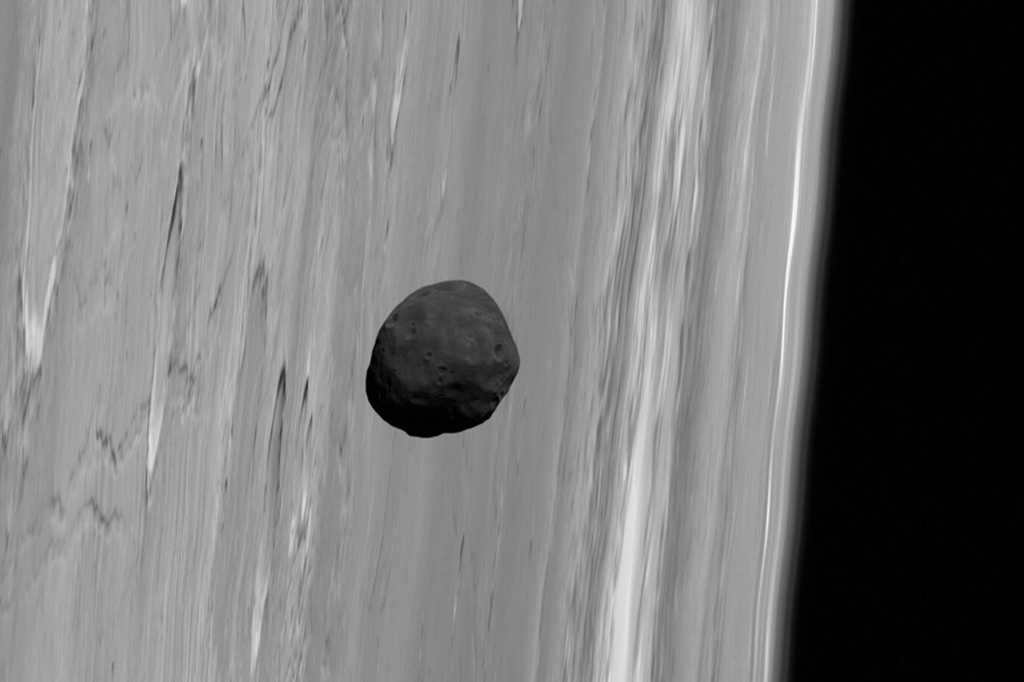
Unfortunately, the first spacecraft was unable to reach its destination, Mars, and the second one only managed to send a limited amount of information and pictures before losing contact. This prevented it from conducting a thorough examination of Phobos’ surface, including the planned landing of a lander.
Unsuccessful attempt to reach the satellite
